The Greek influence is present in all his art, but his own imprint imposes very characteristic styles on the roman painting: life scenes, mythological scenes, landscapes, still lifes or even trompe l'oeil decorations. Architectural decoration was very popular with the Romans.
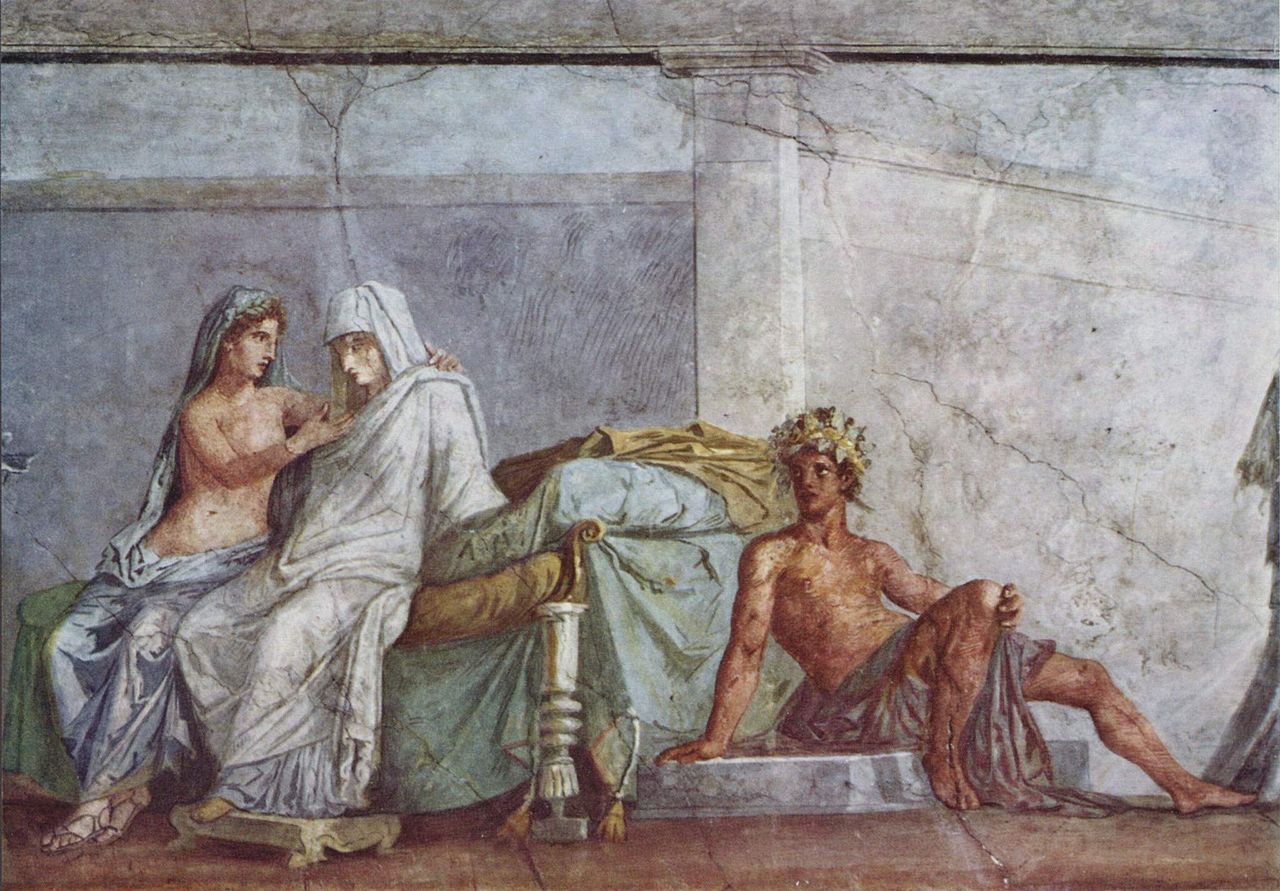
roman painting
Just as Greek art was introduced by the pre-Hellenic civilizations of Crete and Mycenae, Roman art also found a breeding ground in the Etruscan and Greek civilization. Around the years 1000/800 they arrive from the eastern Mediterranean region, probably from Lydia, in Asia Minor, the Etruscan tribes Italy within. Fortunately, they thus supplement the native population; to the heart of Italy they bring a piece of cultural heritage from the East.
As the Etruscans conquered almost the entire Italian peninsula, they contribute a lot to the construction of Roman civilization: their practicality and technical skill leave a deep mark on Roman art. The Greeks also exerted considerable influence on Roman art and civilization.
During the period of the great colonization, 800-550, they swarmed to the shores of the Mediterranean. Do they also settle in Sicily? and southern Italy, which are therefore called Greater Greece. These Greeks bring Greek civilization in all its aspects to Italic soil and influence Roman art more than anyone else.
With the rise of Roman culture, the ancient era entered its final stage. Art in Rome played a completely different role from that in Greece, in which it was inextricably linked with life.
Greek painters, sculptors, architects, philosophers and poets made history themselves. In ancient Rome, this task was performed by the rulers of cities, generals, orators. Their names are inscribed in the annals of history, but the names of Roman painters and sculptors have not come down to us, although they were just as talented as the Greeks.
The end of Etruscan culture was the beginning of Roman art. Probably, before that time there were artists and sculptors in ancient Rome, but no information about them has been preserved. It also affected the fact that almost until the end of the existence of the Republic, Rome constantly waged wars conquering its neighbors, and war, as you know, does not contribute to the development of art.

The country was also rocked by infighting: the commoners fought against the aristocrats, defending their rights; The Italian cities (municipalities) demanded equality with the citizens of Rome. The wars lasted for centuries, without stopping for a single year. Perhaps as a result of these reasons, Roman art as such did not exist until the IV-III centuries BC. Architecture was the first to declare itself: first in the form of bridges and defensive structures, and later - temples.
It is often said that the Romans are not true artists. One can get that impression when comparing the artistic achievements of the Romans with, say, those of the Greeks or the Egyptians. In the early centuries of Roman history, we find little to indicate aesthetic or artistic aspirations; the Romans certainly did not create original art.
If Rome, however, occupies a prominent place in the history of art throughout the centuries, it is because the Romans, after conquering military rule over the world, also recognized the spiritual values and art forms of other peoples. , especially the Greeks, had a great capacity to assimilate and know how to process in a personal way.
General characteristics of ancient Roman painting
Roman painting has come down to us almost exclusively in the form of wall paintings. In this respect, most works of art are still in the place for which they were created and where they are preserved in often difficult conditions. Important evidence of Roman painting are the decorations of tombs and private houses, of temples and sanctuaries throughout the empire.
Greek influence also predominated initially in Roman painting. A specifically Roman site has been found from the XNUMXrd century BC. C. in the so-called triumphal paintings. To honor the victorious generals, paintings were carried as popular reports in the triumphal procession and then displayed in public. Unfortunately, these paintings have not survived and are only attested to in ancient literature.

The custom of painting the interior walls of houses entered Roman cities in the XNUMXnd century BC from the Greek cities of southern Italy, but the Roman decorator painters, drawing on Greek techniques, creatively developed their rich system of wall decoration. .
In Roman wall painting of the XNUMXnd century BC it is customary to distinguish between four decorative styles, which are sometimes called "Pompeian" (because such murals were first discovered in the fresco technique during excavations in Pompeii).
A great contribution to the study of wall paintings in Ancient Rome was made by the German scientist August May, who was responsible for identifying the four styles of Pompeian painting.
The division into styles of painting is quite arbitrary and does not overlap with the general laws of the evolution of Roman painting as a whole.
Roman mural painting can be seen from different positions: First, as a single pictorial composition that decorates this or other premises of a certain size and purpose. Second, as an echo of Greek and Hellenistic compositions.

Third, as a search for this or that cultural standard, a standard of Roman artistic tastes from different eras. Fourth, as a representative of the different artistic currents of Roman painting itself, the technical skills of its creators.
Techniques and styles of Roman painting
The interiors of Roman buildings were often lavishly decorated with bold colors and designs. Wall paintings, frescoes and the use of stucco to create relief effects were done in the XNUMXst century BC
It is used in public buildings, private homes, temples, tombs, and even military installations throughout the Roman world.
Designs ranged from intricate, realistic details to highly impressionistic renderings often covering the entire available wall section, including the ceiling.
The preparation of the plaster was so important that Pliny and Vitruvius explain, in their works, the technique used by painters to fresco the walls: first of all, good quality plaster had to be made that could also be made up of seven successive layers of different composition.
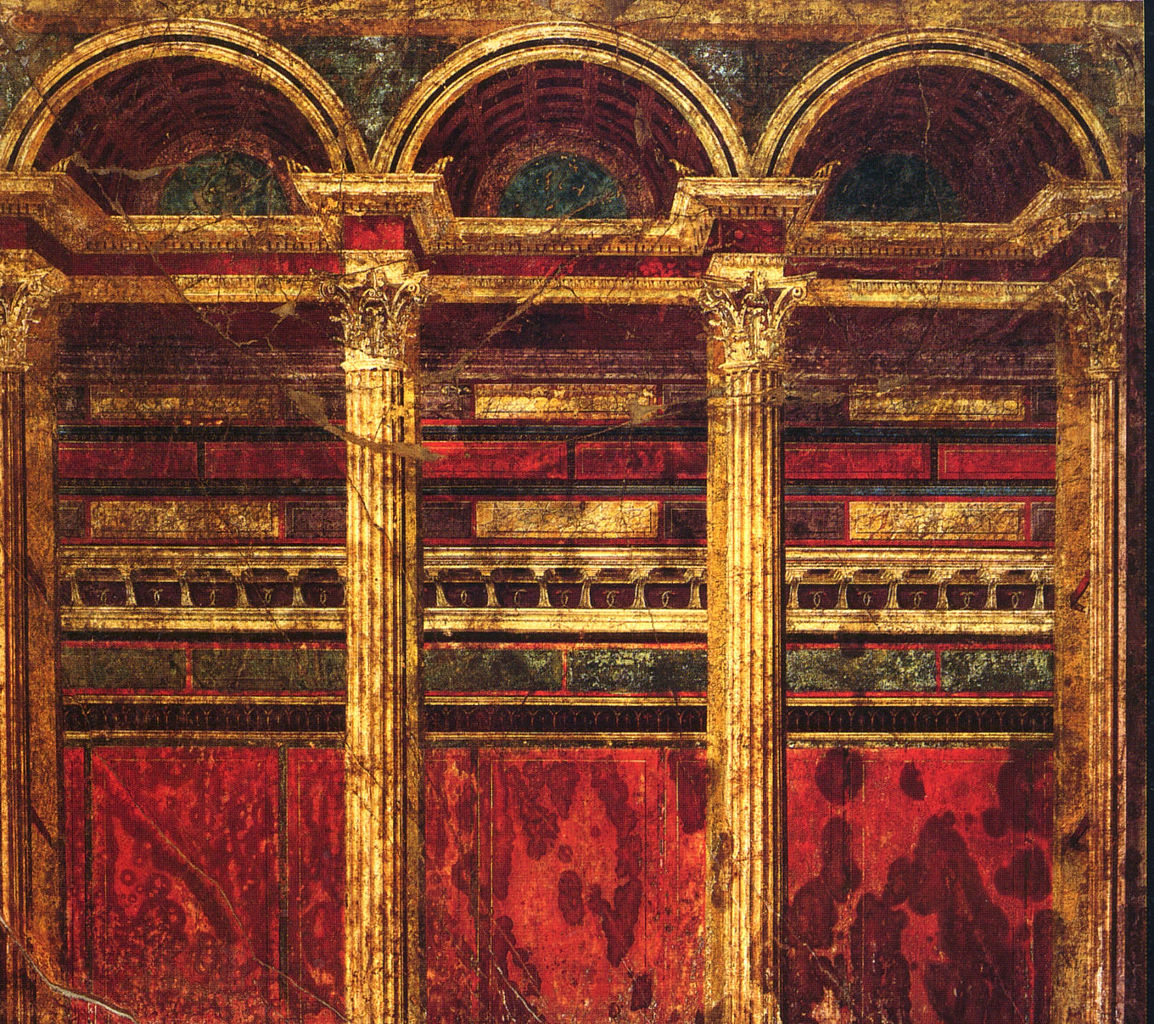
The first was rougher, then the other three were made with mortar and sand and the last three with mortar and marble dust; Generally, layers of plaster were made to a thickness of about eight centimeters, the first one being placed directly on the wall so that it would adhere well, and it was the thickest (three to five cm) made of sand and lime.
Roman wall painters preferred natural earth colors, also darker reds, yellows and ochres. Blue and black pigments were also widely used for simpler designs, but evidence from a Pompeii paint shop shows that there was a wide range of tones.
In the XNUMXrd and XNUMXnd centuries BC, images were not painted directly on the wall. In painted plaster, rectangular slabs of marble, standing and lying, of different types of colors, were imitated, which were used to cover the walls at high altitude. At the top this decoration was closed with a plaster frame, these frames probably contained loose panels. Several examples of this system of decoration have been preserved in Campania, including the House of Sallust in Pompeii.
This followed the fashion that spread throughout the Hellenistic world. Only at the beginning of the XNUMXst century BC did a true Roman art emerge. The plates were no longer rendered in plastic stucco, but instead were painted and the shape suggested by stripes of light and shadow.
Later, the central part of the wall was painted as if it receded slightly and columns were depicted at regular intervals that appeared to be standing on a podium and apparently supported the roof. The top of the wall suggested a view of another room or a courtyard. Architectural constructions were also arranged symmetrically around a painted opening, with a door or gate in the center, as in Publius Fannius Sinistor's villa at Boscoreale, 50-40 BC
The subjects were portraits, scenes from mythology, trompe l'oeil architecture, flora, fauna, and even gardens, landscapes, and entire townscapes to create spectacular panoramas that transport the viewer from the narrow spaces into the limitless world of the imagination that the painter hijacked.
The greatest examples of Roman painting come from the frescoes in the area of Vesuvius (Pompeii and Herculaneum), from the Egyptian tablets of the Fayum and from Roman models, some derived from the Paleo-Christian era (paintings from the catacombs). We have evidence of Roman painting in three techniques:
- Mural painting: done in fresco, on fresh lime, and therefore more durable; the colors were mixed with egg or wax to help them grip;
- Painting on wood or panel: due to the nature of the support, the examples received are rare. A famous exception comes from the tombstones of Fayum (Egypt), fortunately preserved thanks to the particular environmental and climatic situation;
- Abstract painting, applied to objects, for decorative purposes. It is usually characterized by summary and rapid strokes.
In general, earlier paintings and those of wealthier houses show more layers than later paintings and those of less well-off residential buildings. Starting at the top, layers of plaster and then paints were applied to the wall and finally finished at the bottom.
Despite the great differences in details, the walls are built according to the same scheme. There is always a base zone, a middle zone and an upper zone. The base zone is usually quite simple, it can be monochrome, but it can also have imitation marble or simple plant paintings. Geometric patterns are also very popular.
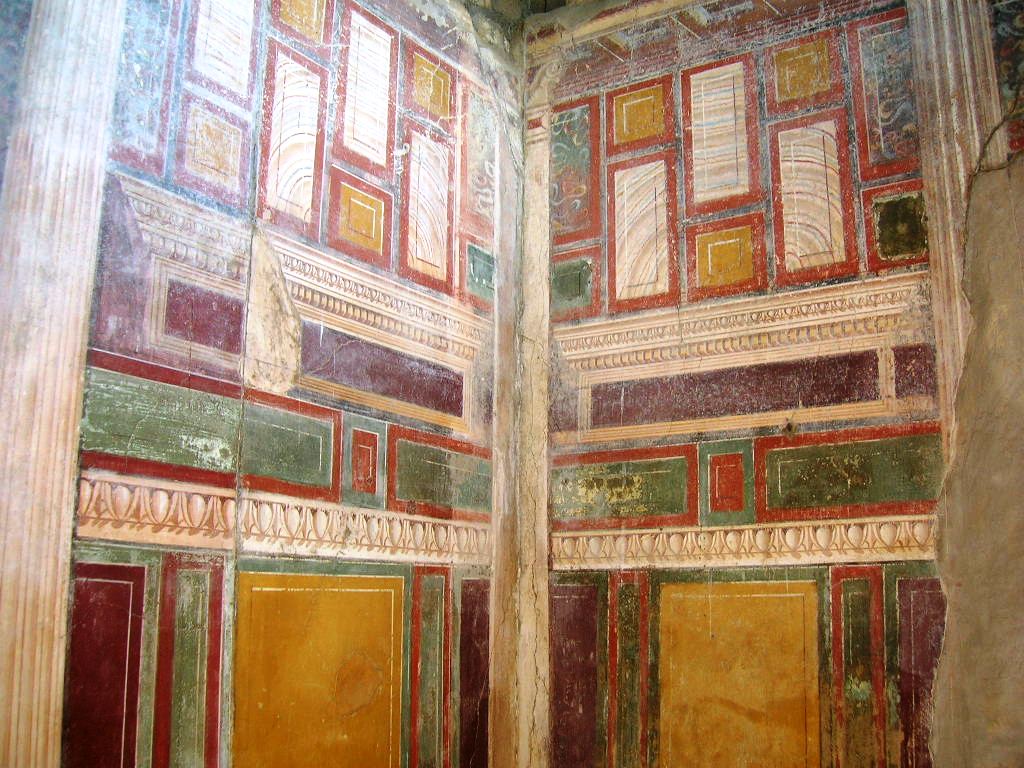
In the middle zone, however, the center of gravity of the painting unfolds. Depending on the style, you will find elaborate architecture or simple fields, with the center of the wall usually being particularly heavy and decorated with a painting.
Field paintings, which were particularly widespread in the third (ornamental) style, consist of an alternation of wide, monochrome, and narrow fields, which are often richly decorated with plants, unreal architecture, or other patterns.
Painting was already practiced by the Etruscans (tomb paintings), but the oldest evidence of pictorial activity in Rome dates back to the first half of the XNUMXth century BC: in particular, the figure of the famous Fabius Pictor (late XNUMXth century BC ) It is remembered, decorator of the Temple of Salus.
The hypothesis is raised that in this oldest phase, Roman painting already presented the peculiar propensity for the festive character of the following centuries, expressed through a fluid and clear narration, as in contemporary sculptural bas-reliefs. Very famous is the so-called Pompeian painting, named after the paintings found in Pompeii, Herculaneum and other countries touched by the eruption of Vesuvius (79 AD). It is divided into four different styles:
the first style
XNUMXrd-XNUMXnd centuries BC, also called "inlays". It corresponded to the life of the Romans of the second century BC. This style is an imitation of colored marble masonry. On the walls of the interior rooms, all the architectural details were made in three-dimensional pieces: pilasters, ledges, cornices, individual masonry brackets, and then everything was painted, imitating finishing stones in color and pattern.
The plaster, on which the paint was applied, was prepared from several layers, where each subsequent layer was thinner.
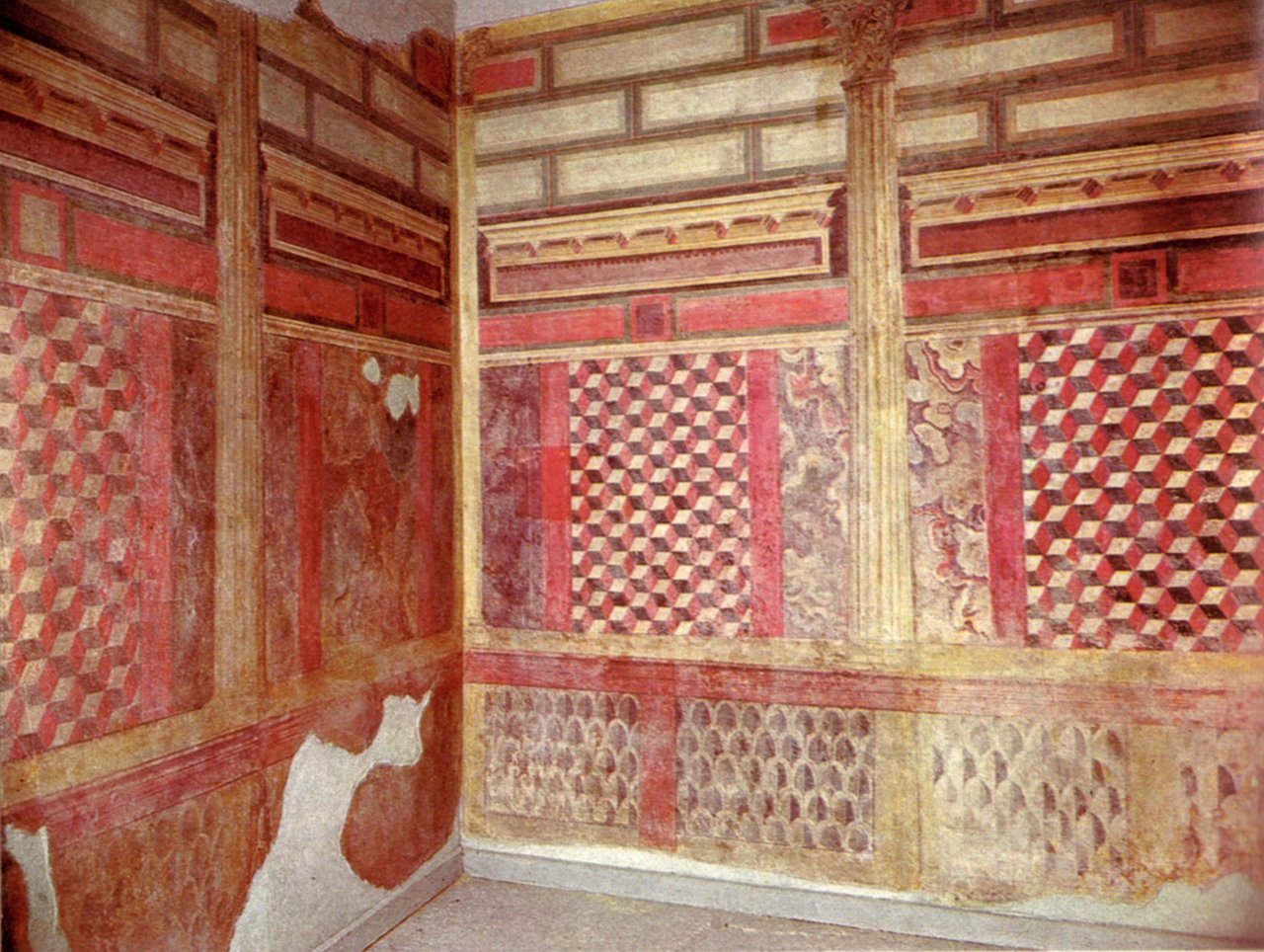
The "inlay" style was an imitation of the interiors of palaces and wealthy houses in Hellenistic cities, where the halls were lined with multi-colored stones (marbles). The first decorative style went out of style in the 80s BC. An example of the "inlay" style is the House of the Faun in Pompeii. The colors used, dark red, yellow, black and white, are distinguished by their purity of tone.
The frescoes in the House of Griffins in Rome (100 BC) may serve as a transitional stage between the first and second decorative styles.
The combination of blue, lilac, light brown colors, a subtle gradation of royal and illustrious painting, flat and volumetric image, between the panel wall decoration and the columns, as it were, protruding from the wall, allows to highlight the painting of the House of Griffins as a transitional way from a petty imitation of masonry to the active spatial way of solving the wall.
the second style
XNUMXnd-XNUMXst centuries BC Called 'architectural perspective', it is, in contrast to the earlier flat style, more spatial in nature. The walls showed columns, cornices, pilasters and capitals with a total illusion of reality, even including deception. The middle part of the wall was covered with images of pergolas, porches, presented in perspective, using chiaroscuro. With the help of decorative painting, an illusory space was created, the real walls seemed to separate, the room seemed larger.
Sometimes individual human figures, or entire multi-figure scenes or landscapes, were placed between the columns and pilasters. Sometimes in the center of the wall there were large pictures with large figures. The plots of the paintings were mostly mythological, less often everyday. Often the paintings of the second style were copies of the works of the ancient Greek painters of the XNUMXth century BC
An example of painting in the second decorative style is the picturesque decoration of the Villa of the Mysteries in Pompeii. In a small room with a high marble-like plinth, against the background of a bright red wall with green pilasters, twenty-nine figures are grouped in life-size.

Most of the composition is dedicated to the mysteries in honor of the god Dionysus. Dionysus himself is also depicted here, leaning on the knees of Ariadne (wife). Elders, young satyrs, maenads, and women are shown here.
Very interesting is the scene in which an old strong man, depicted on one wall of the room, directs his gaze towards the young maenad, who is depicted on the other wall. At the same time, Silenus taunts a young satyr with a theatrical mask in his hands.
Another painting scene is also interesting, showing a formidable goddess whipping a kneeling girl with a long whip on her bare back trying to become a full participant in the mysteries. The girl's pose, the expression on her face, the dull eyes, the tangled strands of black hair convey physical suffering and mental anguish. This group also includes the beautiful figure of a young vacant dancer who has already passed the required tests.
The composition of the fresco is based not so much on the proportion of volumes in space, but on the juxtaposition of silhouettes on a plane, although the figures represented are voluminous and dynamic. The entire fresco is connected into a single whole by gestures and postures of the characters depicted on various walls. All the characters are illuminated by soft light streaming from the ceiling.
The naked bodies are magnificently painted, the color scheme of the clothes is extremely beautiful. Even though the background is bright red, no detail disappears against this contrasting background. The participants in the mysteries are represented to create the illusion of their presence in the room.
A peculiar feature of the second style is landscape images: mountains, sea, plains, enlivened by various grotesquely performed figures of people, executed schematically. The space here is not closed, but free. In most cases, the landscape includes images of architecture.
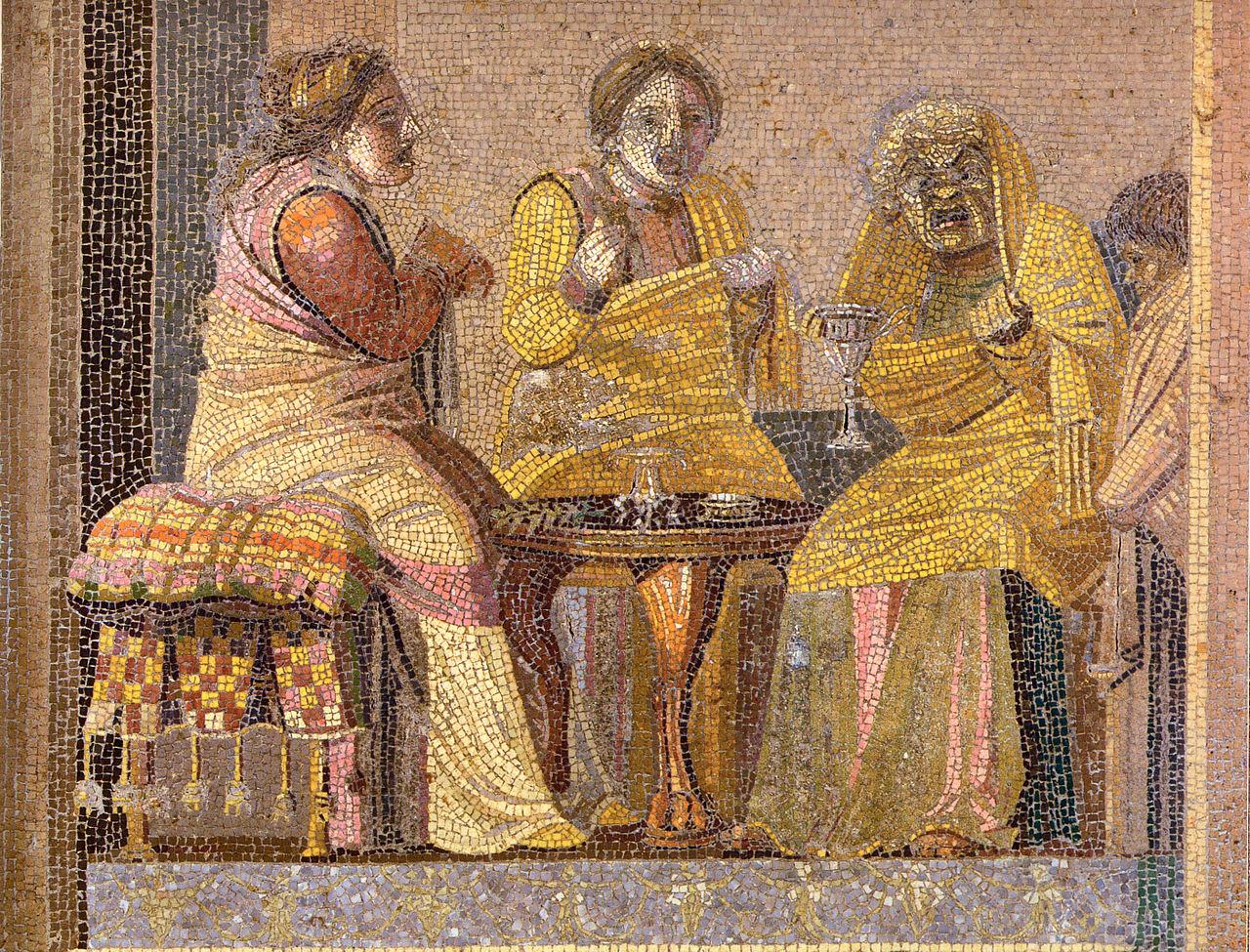
At the time of the Roman Republic, a pictorial easel portrait was very common. In Pompeii there is a portrait of a young woman with writing tablets, as well as an image of the Pompeian Terentius with his wife. Both portraits are painted in a moderate painterly manner. They are distinguished by a good transfer of facial plastics. deep portraits.
the third style
The third Pompeian style (late XNUMXst century BC – early XNUMXst century AD) corresponded to the ornamental style. Instead of picturesque decorations, with the aim of separating and replacing the royal walls, there are paintings that decorate the wall without breaking its plane.
The paintings, on the contrary, emphasize the plane of the wall, decorating it with delicate ornaments, among which very graceful columns predominate, more like metal chandeliers. It is no coincidence that the third decorative style is also called "chandelier".
In addition to this light architectural decoration, small paintings with mythological content were placed in the center of the wall. Still life, small landscapes and everyday scenes are introduced into the ornamental decoration with great skill.
Garlands of leaves and flowers painted on a white background are very characteristic. Painted flower jewelry, ornaments, miniature scenes and still lifes require close viewing. The painting of the third style emphasizes the comfort and intimacy of the room.

The palette of the artists of the third style is interesting and varied: a black or dark purple base, on which small bushes, flowers or birds used to be depicted. In the upper part, alternating panels of blue, red, yellow, green or black were presented, on which small paintings, round medallions or scattered loose individual figures were placed.
Roman artists elaborated the Greek solution of mythological scenes in accordance with the prevailing style. Serious facial expressions, calm posture and moderation of gestures, statuesque figures.
Greater attention was paid to a clear outline that clearly delineates the folds of the garment. An example of the third style is Cicero's Villa in Pompeii. Idyllic pastoral landscapes have survived in Pompeii and Rome. Usually small-sized paintings, somewhat sketchy, sometimes painted with one or two colors.
the fourth style
The fourth decorative style developed in the second half of the XNUMXst century. The fourth style is sophisticated and exuberant, combining the promising architectural constructions of the second style with ornamental decorations of the third style.
The ornamental part of the paintings takes on the character of fantastic architectural compositions, and the paintings located in the central parts of the walls have a spatial and dynamic character.
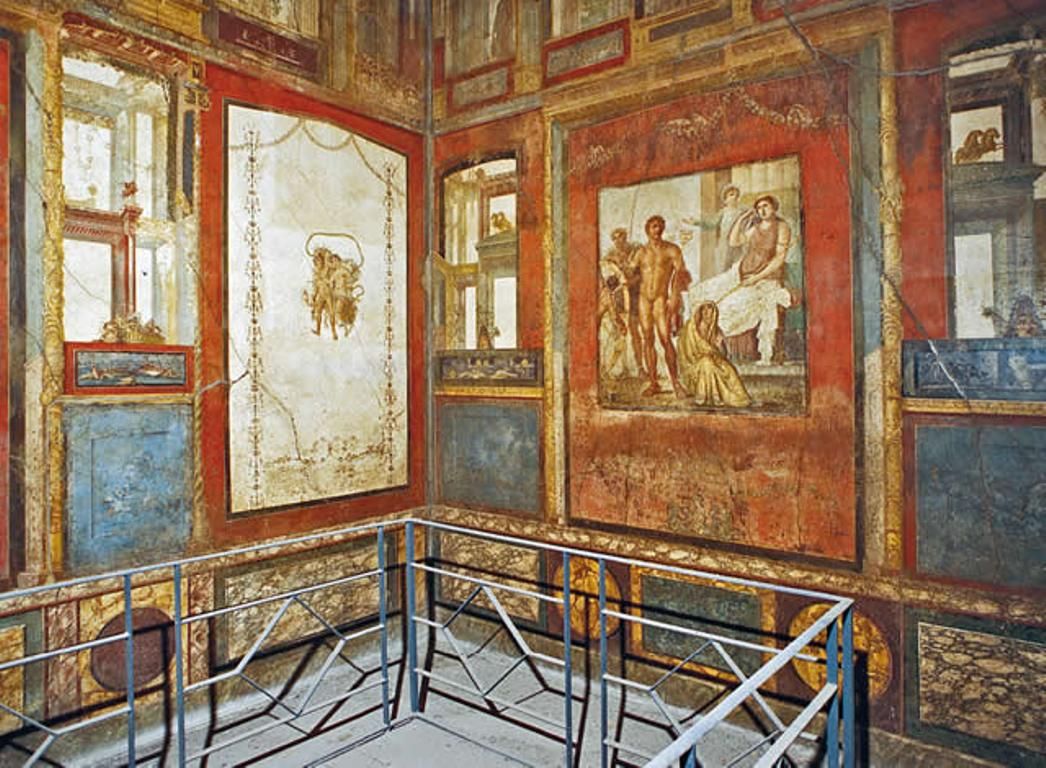
The range of colors is usually varied. The plots of the paintings are mostly mythological. The multitude of irregularly lit figures, depicted in rapid motion, enhance the impression of spaciousness. The fourth-style painting again breaks the plane of the wall, expands the boundaries of the room.
The masters of the fourth style, creating murals, depict on the walls a fantastic magnificent portal of the palace, or narrative paintings, alternating with "windows" through which parts of other architectural structures are visible.
Sometimes, on the upper part of the wall, the artists painted galleries and balconies with human figures, as if looking at those present in the room. For painting in this style, the selection of paints was also characteristic. Especially at this time they represent compositions with dynamic or sharp actions
In Pompeii murals and a purely Roman spirit have been preserved. For example, on Calle de la Abundancia, at the entrance to the dyer Verecundo's workshop, on the exterior wall there was a painting made with precision and scrupulosity, which portrays all the processes of the dyer and his assistants. An example of the fourth style is the painting of Nero's palace in Rome (the Golden House), the picturesque decoration of which was directed by the Roman artist Fabullus.
It was the most sumptuous style, combining the fantastic and illusionistic architecture of the second style, false marble panels and ornamental elements of the third style (House of the Vettii in Pompeii, House of the Dioscuri). In this period there are majestic examples of architecture with theatrical and scenographic effect that, however, rework and combine elements drawn from earlier styles.
Many Pompeian villas were decorated in this style from the reconstruction after the earthquake of 62 AD An example of them is the House of the Vettii, decorated with scenes of daily life (eg fight between roosters) and, above all, all, scenes with a mythological subject.
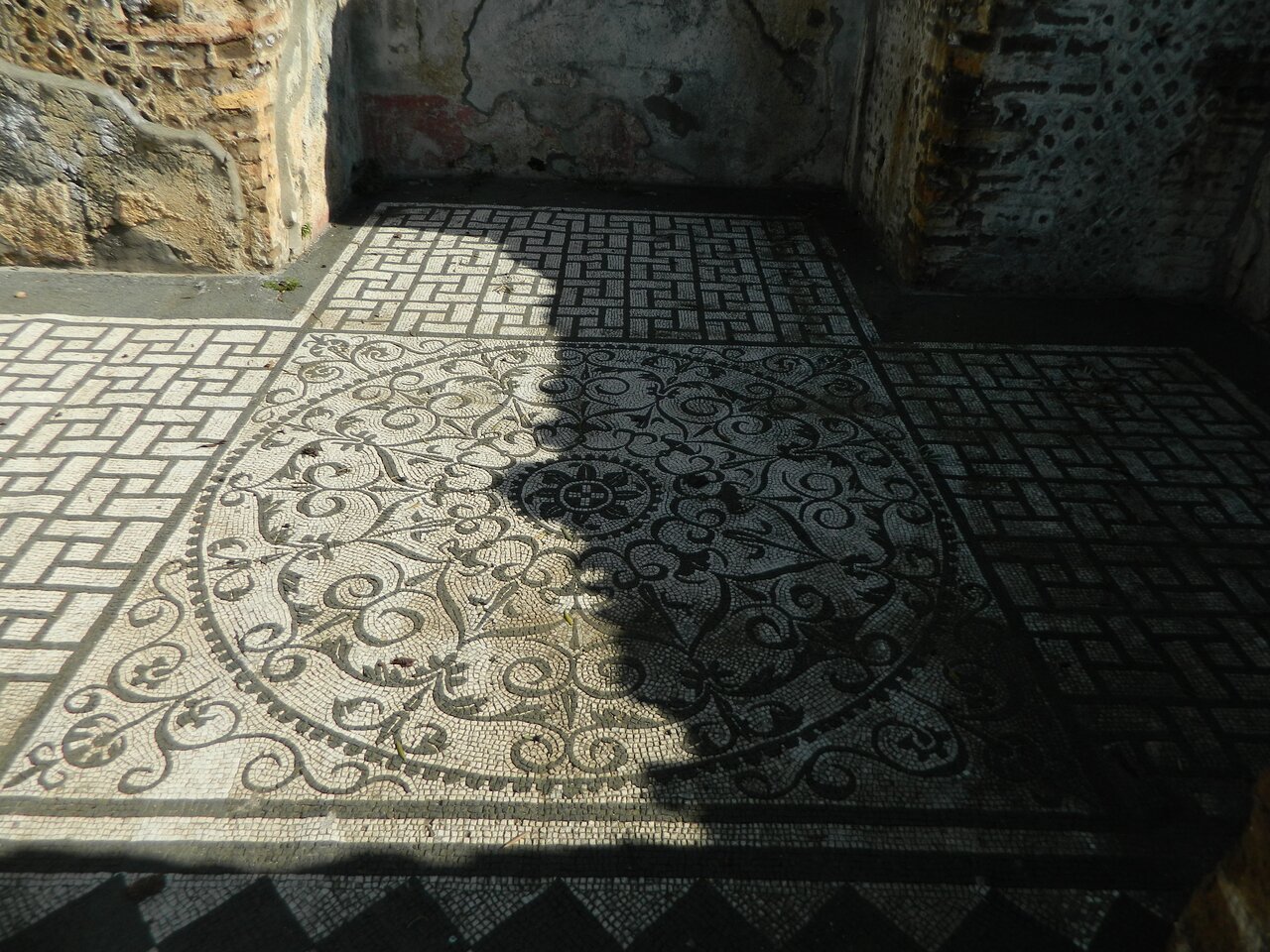
The originality of Roman mural painting of the II-III centuries
After the disappearance of Pompeii, Herculaneum and Stabiae in 79 AD It is very difficult to trace the path of development of ancient Roman painting, since the monuments dating back to the II-IV centuries are very few. We can definitely say that wall painting in the XNUMXnd century became more prevalent. In contrast to the fourth decorative style, where the illusion of a large space was created, the plane of the wall is now emphasized. The wall is linearly interpreted by individual architectures.
In addition to painting when decorating the room, various types of marble were used as well as mosaics placed both on the floor and on the walls. An example is the painting of the Emperor Hadrian's villa at Tivoli, near Rome. At the end of the XNUMXnd century and the first half of the XNUMXrd century, decorative painting techniques were further simplified.
The plane of the wall, ceiling, vault surface of the tomb was divided by dark stripes into rectangles, trapezoids, or hexagons, inside of which (as in a frame) a male or female head, or a motif, was painted. decoration of plants, birds and animals.
During the XNUMXrd century, a way of painting was developed, which is characterized by strokes that emphasize only the main volumes and follow the plastic form. Dense dark lines, well defined eyes, eyebrows, nose. The hair was usually treated in bulk. The figures are schematic. This style became especially popular when painting Christian catacombs and Roman tombs.
At the end of the XNUMXrd century mosaics are especially popular. Mosaic figures are distinguished by the rigidity of the poses, the line drawing of the folds of clothing, the location of the color scheme, and the general plane of form. The faces of the represented characters lack individual features.
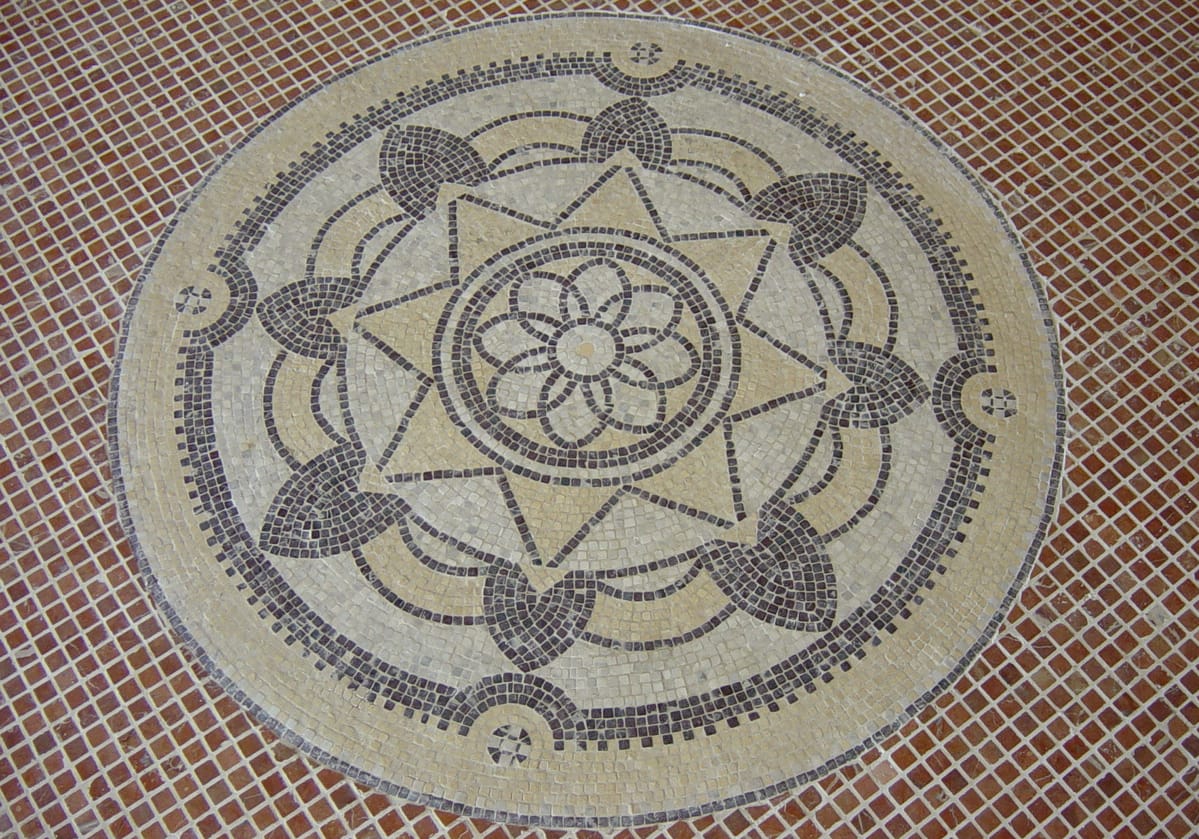
It was common for the nobility to have the walls of their villas and private houses decorated and that is why most of the pictorial evidence that has come down to us derives from this context. Very important for Roman painting was the Greek influence, derived from the knowledge of Greek sculptures and paintings, but above all from the spread of Greek painters in Rome. From the Hellenistic sphere, Roman painting not only inherited decorative themes but also naturalness and representative realism.
Fayum funerary portraits
Along with Roman and bell painting, there are the famous Fayum Portraits (XNUMXst century BC – XNUMXrd century AD) which are a series of Egyptian tablets similar to the portraits that were placed on the deceased during the burial. The subjects were portrayed alive, with a strong realism of the faces, represented frontally and often on a neutral background. Characteristic of these tablets is an exceptional pictorial vivacity.
An exemplary case of integration between different cultures, this group of paintings is known as the Fayum Portraits because of the place where they were found. There are about six hundred funerary portraits, made on wooden boards with the encaustic or tempera technique between the XNUMXst and XNUMXrd centuries, and preserved in excellent condition thanks to the dry climate of the place. The population that lived here was of Greek and Egyptian origin but was already strongly Romanized in its uses, adapting them to its own traditions.
This type of painting on the table is a real painting of the deceased and is part of the local funeral rites: the cost could also be very high since the portrait could be decorated with gold leaves to imitate jewels and precious objects, it was placed between the mummy's bandages for a few days during the exhibition of the body at home before burial.
Egyptian Rite, Greek Custom but Roman Style: This community was affected by Roman art and copied its themes and trends; all portraits have a neutral background, but are highly plausible in the rendering of facial features and details of clothing and hairstyles.
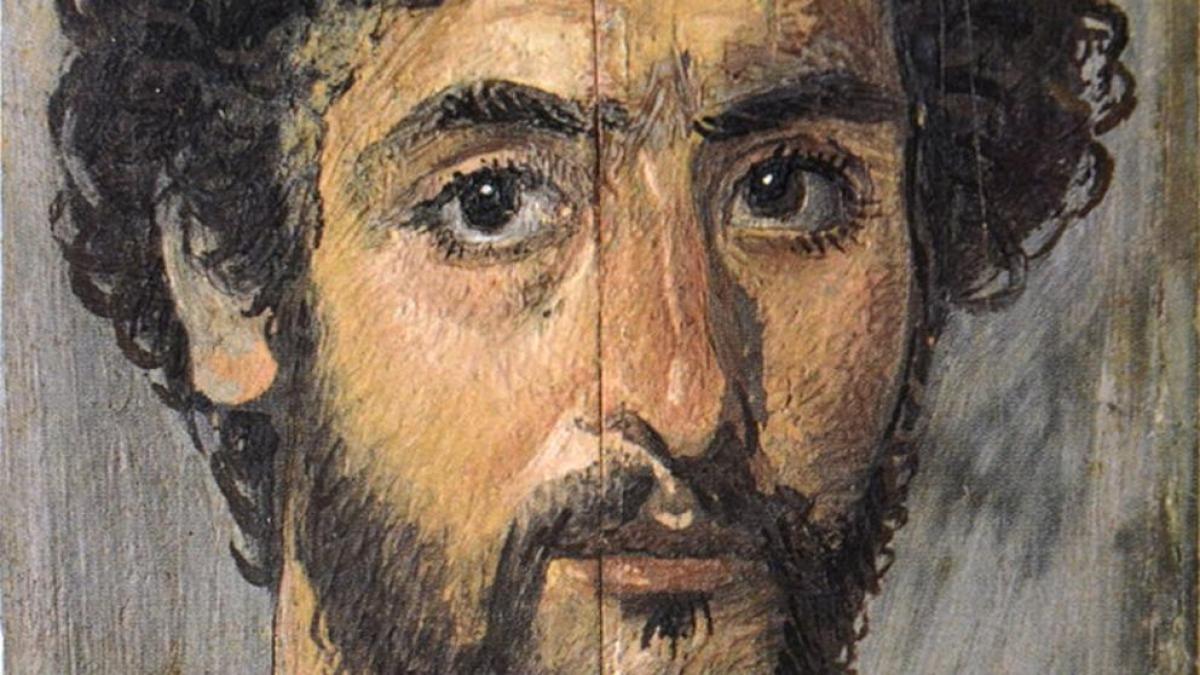
In this production there are recurring characters that were also widespread in Rome: the large eyes, the fixed gaze and the volumetric simplification (annulment of the contour planes and body) are also found in some Roman portraits of the Severe period and shortly after.
Classifiable as the first example of biblical painting are the paintings of Dura Europos (Syria), dating back to the first half of the third century. The invention of the new Christian iconography is shown here to be highly influenced by the Hellenistic-Jewish iconographic tradition: the first Christian illustrations extract, in fact, elements and iconography from the Jewish and pagan repertoire, endowing them with a new religious meaning.
Given the close iconographic and stylistic affinities, it is believed that the artists worked simultaneously for pagan and Christian clients. The realism that had always characterized Roman painting was slowly lost in late antiquity when, with the spread of provincial art, forms began to be simplified and often symbolized.
It is the advent of early Christian painting, known above all through the paintings of the catacombs that combine biblical scenes, decorations, figures from a still pagan context and a rich repertoire of symbols alluding to Christian figures and content (for example, the fish , The Good Shepherd). The most famous examples come from the catacombs of Priscilla, Callisto and SS. Pietro and Marcellino (Rome).
The Roman Mosaic
In addition to the Alexander mosaic, smaller scenes, mostly square, composed of multi-coloured stones, have been found at Pompeii and were incorporated as the center of more simply made floors. The so-called emblemata dates back to the XNUMXst century BC. Similar Hellenistic mosaics have been found on Delos. The images, which often have Bacchus on a panther or still lifes as their subject matter, resemble paintings.
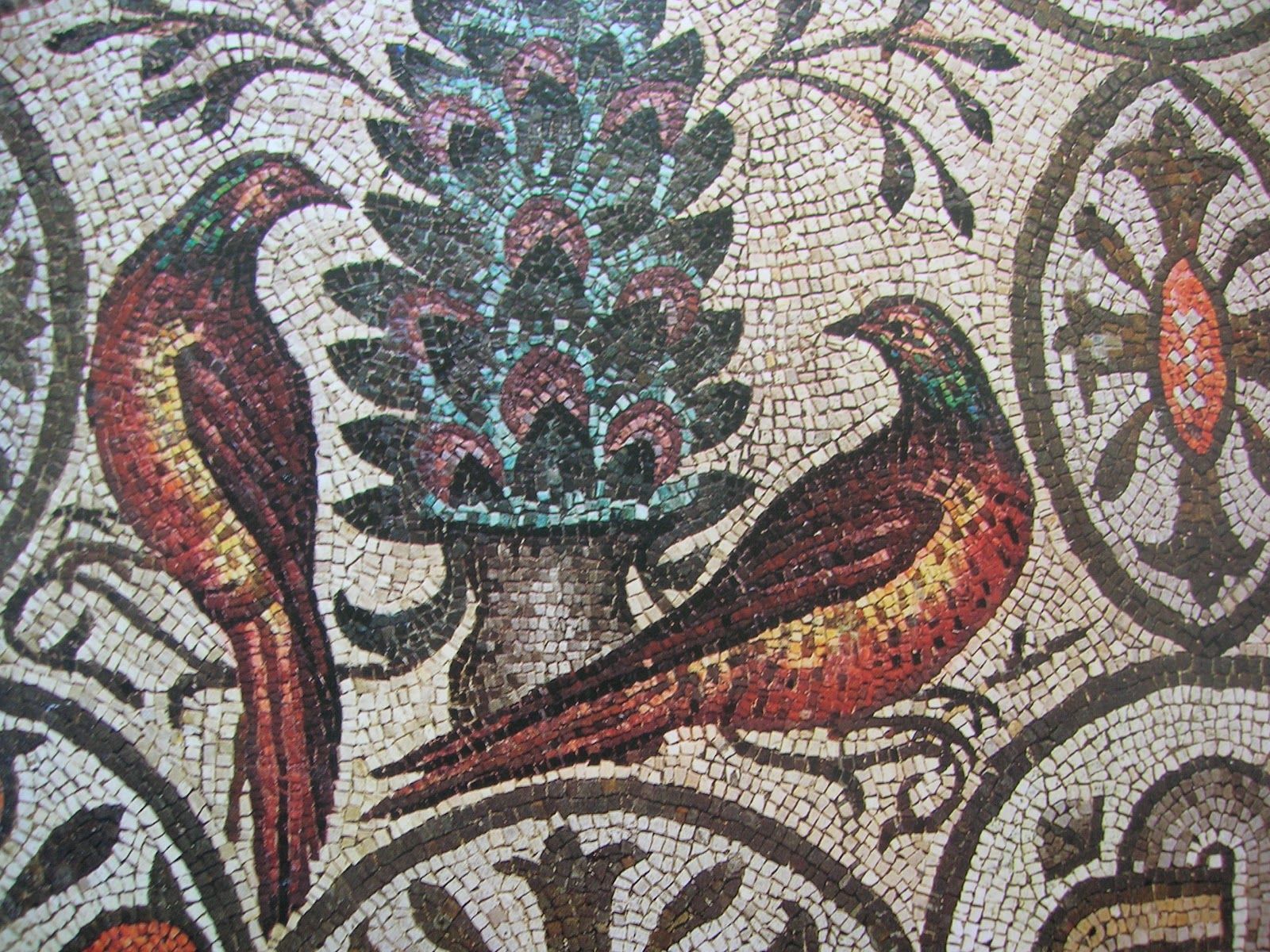
It is different with black and white floors, which appeared in Italy in the XNUMXst century BC. They were executed in marble and had geometric motifs, stylized plants and flowers, and simplified representations of humans and animals as their theme, and completely fit their architectural function. This black and white mosaic, typical of Italy, only really developed in the XNUMXnd century AD, especially in Ostia, where large compositions of sea creatures were made.
In the northwest of the empire they initially joined the black and white tradition of Italy, but from the middle of the XNUMXnd century AD people began to use more and more color. The division into square and octagonal surfaces, on which various images were arranged, was popular there.
Mosaic art flourished in North Africa, where great mythological scenes and scenes from everyday life were depicted in many colors on floors (Piazza Armerina villa in Sicily). Polychrome mosaics are also preserved in Antioch. In the XNUMXst century AD, wall mosaics were mainly used where painting was less suitable (eg on well buildings). Wall and vault mosaics from the XNUMXnd and XNUMXrd centuries have been almost completely lost.
The wall mosaic only fully developed in Christian churches (XNUMXth century). In addition to mosaic, a technique called opus sectile was also used, in which figures and motifs were made up of large pieces cut from different types of marble. This technique was used not only for floors, but also for walls.
Curiosities
- According to Pliny, the colors were divided into 'flowery' (minium, armenium, cinnabaris, chrysocolla, indicum and purposorum) that had to be purchased directly by the client and "austere", which instead were included by the artist in the final price of the work. and generally included yellow and red ochre, earths, and Egyptian blue
- It was discovered that in the Imperial Villa of Pompeii the paintings in the corridors, all belonging to the third style, had been restored a few years before the eruption and only fifty years after its construction, which demonstrates the great value already attributed in antiquity .
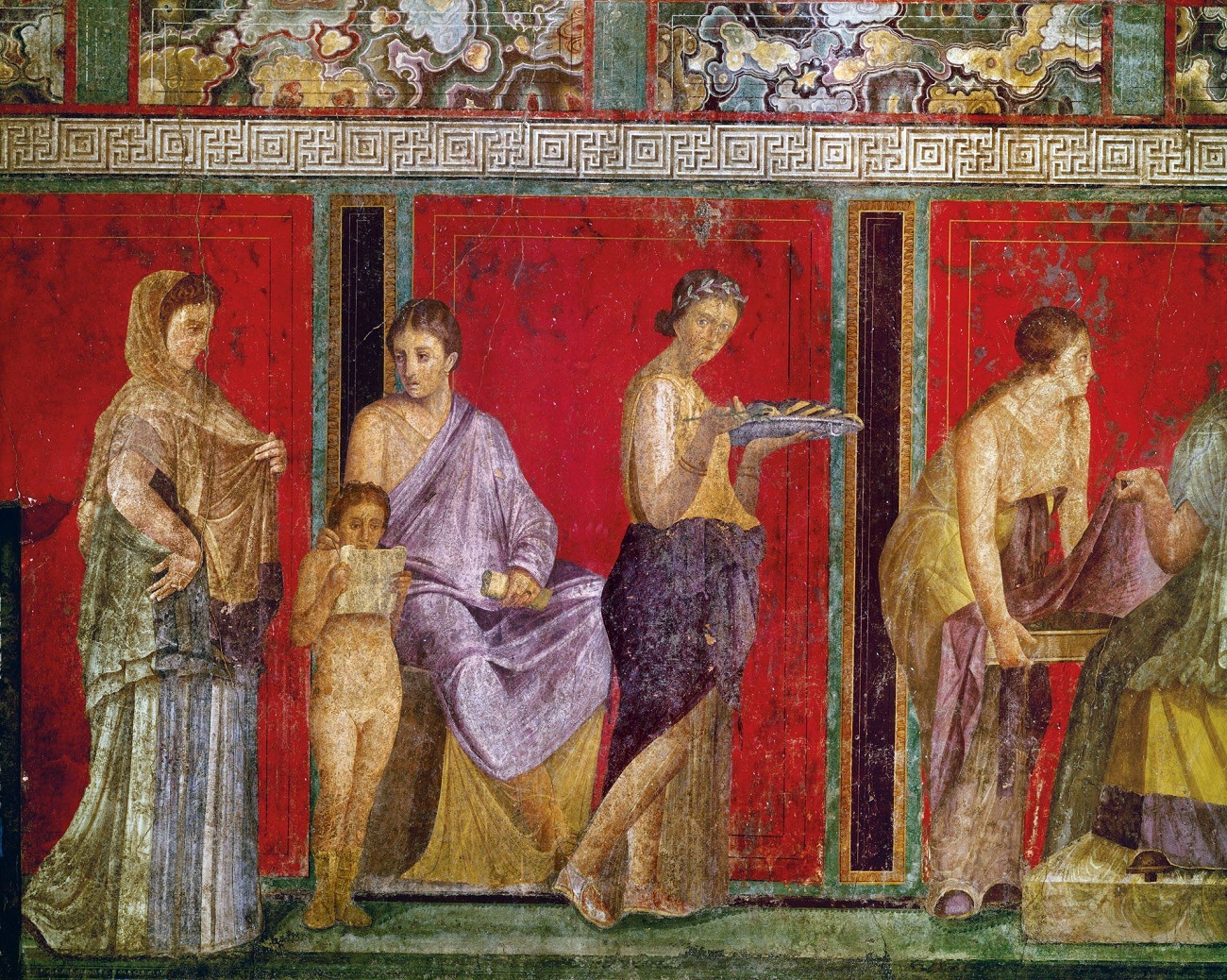
- The nature represented in Roman painting is always and only that of the gardens: in the mentality of the time spontaneous nature was combined with barbarian customs and the absence of civilization, the only representations tolerated are those of wild animals in hunting scenes mythological.
- In the fifteenth century in Rome a "cave" with completely painted walls was accidentally discovered: it was the Domus Aurea of the Emperor Nero. The court painter Fabullus or Amulius from 64 to 68 AD works in the Domus Aurea, frescoing most of the rooms in the fourth Pompeian style.
Colors
The colors were made with pigments of vegetable or mineral origin and Vitruvio in De Architectura speaks of a total of sixteen colors including two organic, five natural and nine artificial. The first are black, obtained by calcining the resin with pieces of resinous wood or pomace burned in the oven and then bound with flour, and purple, derived from murex, which was used more in the tempering technique.
The colors of mineral origin (white, yellow, red, green and dark tones) were obtained by decantation or calcination. Decantation is a separation technique that consists of separating two substances from a solid-liquid mixture by the force of gravity (in practice, the solid settles at the bottom of a container until all the liquid above clears up).
Calcination is a high-temperature heating process that is continued for as long as it takes to remove all volatile substances from a chemical compound and has been used since ancient times for the production of paint pigments, including cerulean. The nine artificial ones were obtained from the composition with various substances and among these the most used were cinnabar (vermillion red) and cerulean (Egyptian blue).
Cinnabar, of mercurial origin, was difficult to apply and maintain (it darkened on exposure to light) and was very expensive and highly sought after. It was imported from the mines near Ephesus in Asia Minor and from Sisapo in Spain. Cerulean was made from crushed nitro fleur sand mixed with wet iron filings that were dried and then fired into pellets.

This color was imported to Rome by a banker, Vestorius, who sold it under the name Vesterianum and cost about eleven denarii. The law established that the client provided the "flowery" colors (the most expensive) while the "austere" (cheapest) colors were included in the contract. The workshop, perhaps, was made up of a teacher with his assistants.
These highly esteemed craftsmen became part of the store's instrumentum, and when the store was sold to other owners, they too, along with the work tools (level, plumb line, square, etc.) and tools, changed hands. owner. His work began at dawn and ended at dusk, and although his works were visited and admired, they were not taken into consideration.
Here are some links of interest: